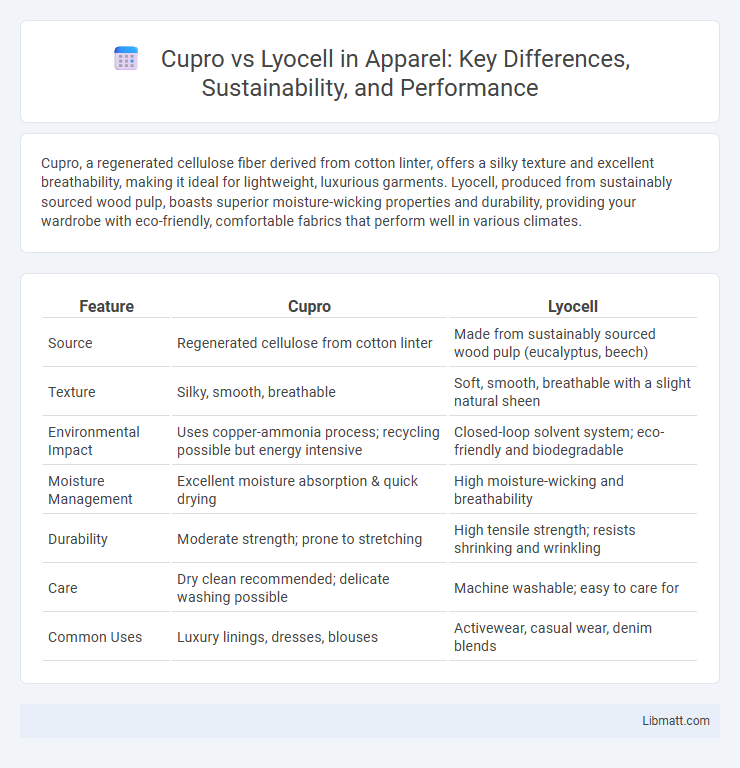Cupro, a regenerated cellulose fiber derived from cotton linter, offers a silky texture and excellent breathability, making it ideal for lightweight, luxurious garments. Lyocell, produced from sustainably sourced wood pulp, boasts superior moisture-wicking properties and durability, providing your wardrobe with eco-friendly, comfortable fabrics that perform well in various climates.
Table of Comparison
| Feature | Cupro | Lyocell |
|---|---|---|
| Source | Regenerated cellulose from cotton linter | Made from sustainably sourced wood pulp (eucalyptus, beech) |
| Texture | Silky, smooth, breathable | Soft, smooth, breathable with a slight natural sheen |
| Environmental Impact | Uses copper-ammonia process; recycling possible but energy intensive | Closed-loop solvent system; eco-friendly and biodegradable |
| Moisture Management | Excellent moisture absorption & quick drying | High moisture-wicking and breathability |
| Durability | Moderate strength; prone to stretching | High tensile strength; resists shrinking and wrinkling |
| Care | Dry clean recommended; delicate washing possible | Machine washable; easy to care for |
| Common Uses | Luxury linings, dresses, blouses | Activewear, casual wear, denim blends |
Introduction to Cupro and Lyocell
Cupro is a regenerated cellulose fiber derived from cotton linter, known for its silky texture and breathability, making it popular in luxury fashion and sustainable textiles. Lyocell is an eco-friendly fiber produced from sustainably sourced wood pulp through a closed-loop process, valued for its softness, moisture-wicking properties, and biodegradability. Both fibers offer sustainable alternatives to synthetic fabrics, combining performance with environmental responsibility.
Origins and Production Processes
Cupro, a regenerated cellulose fiber derived from cotton linter, undergoes a chemical-intensive process involving copper ammonium solution to transform cellulose into fabric, emphasizing its semi-synthetic origin. Lyocell, produced from sustainably sourced wood pulp, uses a closed-loop solvent spinning process with non-toxic amine oxide, minimizing environmental impact and waste. Understanding these distinct origins and production methods helps you choose between the eco-friendly credentials of lyocell and the luxurious smoothness of cupro.
Environmental Impact Comparison
Cupro, derived from cotton waste cellulose, undergoes a chemical-intensive production process that raises concerns about water pollution and chemical waste management. Lyocell, made from sustainably sourced wood pulp using a closed-loop process, significantly reduces environmental impact by recycling 99% of the solvents and minimizing water usage. Your choice between cupro and lyocell influences sustainability, with lyocell generally recognized as the more eco-friendly fabric option.
Fabric Feel and Texture Differences
Cupro fabric offers a silky, smooth texture with a luxurious, breathable feel that resembles fine silk, making it ideal for elegant garments. Lyocell features a softer, more matte finish with a slightly heavier drape and excellent moisture-wicking properties, enhancing comfort in casual or activewear. Your choice depends on whether you prefer the glossy, refined touch of cupro or the natural softness and durability of lyocell.
Durability and Longevity
Cupro offers moderate durability, maintaining its softness and sheen over time but is prone to weakening when exposed to prolonged moisture or heat. Lyocell, known for its exceptional strength, resists wear and tear while retaining fibers' integrity through multiple washes, making it highly durable. Both fibers provide longevity in garments, but lyocell outperforms cupro in maintaining structural resilience and color retention under frequent use.
Moisture Management and Breathability
Cupro offers excellent moisture management due to its natural cellulose fibers, allowing it to absorb sweat and release it efficiently, resulting in superior breathability and comfort. Lyocell, made from sustainably sourced eucalyptus pulp, excels in wicking moisture away from the skin while maintaining high breathability, enhancing dryness and temperature regulation. Both fibers outperform synthetic fabrics in moisture handling, with Cupro providing a silk-like softness and Lyocell offering durability and eco-friendly benefits.
Dyeing and Color Retention
Cupro offers excellent dye absorption due to its cellulose content, resulting in vibrant and rich color tones with strong color retention after multiple washes. Lyocell, derived from wood pulp, allows uniform dye penetration and maintains colorfastness because of its smooth fiber surface and moisture-wicking properties. Both fibers perform well in color retention, but Cupro excels in achieving deeper hues while Lyocell is favored for maintaining brightness and resisting fading over time.
Common Uses and Applications
Cupro is widely used in luxury linings and high-end fashion due to its silky texture and breathability, making it ideal for suits, dresses, and scarves. Lyocell, known for its moisture-wicking and durability, is common in activewear, casual clothing, and home textiles such as bed linens and upholstery. Your choice between these fibers depends on the desired feel, performance, and sustainability requirements of the final product.
Care and Maintenance Requirements
Cupro fabric requires gentle hand washing or delicate machine cycles with mild detergent to maintain its silky texture, avoiding high heat and direct sunlight to prevent damage. Lyocell is more durable, allowing machine washing in cold water and low heat tumble drying, but it should be air-dried to reduce shrinkage and preserve fiber strength. Both fabrics benefit from ironing at low temperatures and avoiding bleach to extend garment lifespan.
Which Fabric to Choose?
Cupro offers a silky texture with excellent breathability and moisture-wicking properties, making it ideal for luxurious, lightweight garments that require a smooth drape. Lyocell, derived from sustainably sourced wood pulp, provides superior durability, wrinkle resistance, and eco-friendly benefits, perfect for everyday wear and active lifestyles. Choosing between cupro and lyocell depends on prioritizing fabric feel and luxury versus sustainability and practicality.
cupro vs lyocell Infographic

 libmatt.com
libmatt.com